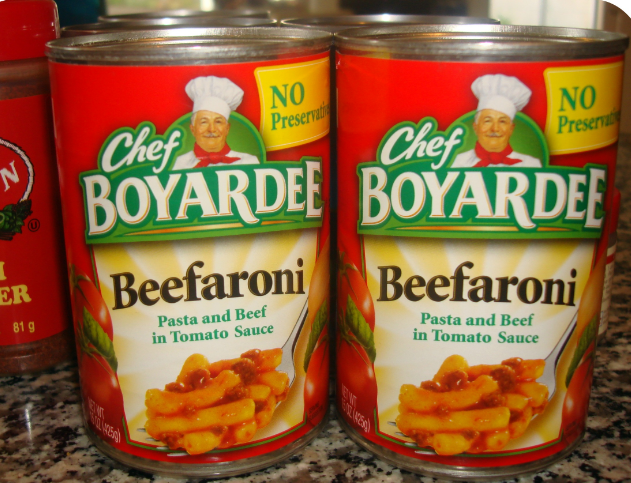The Man Behind the Can

Pictured above are a few cans of Beefaroni, the pasta product with an unnaturally long shelf-life and which costs about a buck or two. You cook it by opening the can, dumping its contents into a small pot, taking a few minutes to reheat it on the stove, and… okay, that’s it. It’s a cheap, easy, and probably tasty meal (I can’t actually claim to have ever eaten it), but it’s not something you’d expected to see at a wedding or at a fancy dinner party.
Unless you’re Woodrow Wilson.
Okay, that’s a stretch — Woodrow Wilson was President from 1913 to 1921 and died shortly thereafter in 1924, and the Chef Boyardee brand didn’t debut until 1928. So it’s impossible for Wilson to have been a fan of the canned pasta. However, it’s clear that President Wilson was a fan of Chef Boyardee, or, more accurately, its namesake and founder, Chef Hector Boiardi.

That’s Hector Boiardi (pronounced, you guessed it, “Boy-ar-dee”) pictured above. He was born in Italy in 1897 and immigrated to the United States in the spring of 1914. In either 1924 or 1926 — reports vary — he, his family, and his brothers and their families ended up in Cleveland, where they opened what was probably the city’s first Italian restaurant. As NPR reported, the restaurant was a success — and the community’s interest in Italian cuisine went beyond the restaurant’s four walls: “customers expressed interest in learning how to make Italian dishes at home.” Boiardi and his brothers “started sending people home with pasta, sauce and cheese and teaching them how to cook, heat and assemble the dishes themselves.”
From there, a food service entrepreneur approached Boiardi with an idea for a partnership — canned spaghetti and meatballs. The rest is culinary history.
But before Bioardi was the pasta king of Cleveland, he had some other stateside jobs. After coming to America, he ended up in the kitchen at the Plaza Hotel, the landmark resort on the southeast corner of Manhattan’s Central Park. He was the head chef there before his 18th birthday and then, by 1915, found another job at the Greenbrier, a famous (check out the “From the Archives” link below) hotel in West Virginia.
That year, a young Woodrow Wilson married Edith Bolling at the Greenbrier, and the event was catered by the hotel’s top chef — that is, by Hector Boiardi. It’s unlikely that Wilson, Bolling, and their guests dined on mini pasta dinosaurs or Cheeseburger Maxx, of course. And it’s likely that whatever the meal was, Wilson liked it; a few years later, per Wikipedia, Wilson hosted a homecoming meal at the White House for 2,000 soldiers returning from World War I. The caterer was the man who would later be known as Chef Boyardee. And again, he probably didn’t heat-and-serve pasta. Probably.
Bonus fact: Ultimately, many soldiers did get Chef Boyardee pre-cooked pasta. In World War II, the company was one of the largest providers of rations to the U.S. troops — and also, to the Soviets. There are some reports (see Wikipedia’s summary) that, in gratitude for this service, Bioardi received the Order of Lenin, the highest honor given by the Soviet Union. But concrete sources for this fact are hard to come by — because the Cold War broke out just as World War II ended, Bioardi wouldn’t have been able to accept or publicly acknowledge the award.
From the Archives: Into the Brier Patch: The government’s secret hideaway at the Greenbrier.
Related: Beefaroni. Or, if you prefer, SpaghettiOs, which (I hadn’t realized until now) aren’t a Chef Boyardee product.
